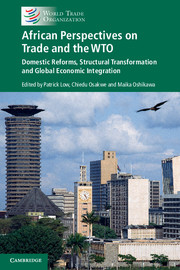 African Perspectives on Trade and the WTO
African Perspectives on Trade and the WTO from Part I - The Future of the Multilateral Trading System: Perspectives from African Policy-Makers and Partners
Published online by Cambridge University Press: 27 October 2016
The obstacles to deeper African integration are great, but the potential gains for development and poverty reduction warrant a sustained effort to overcome these challenges. High trade barriers between countries have been reflected in trade that is more oriented toward distant markets than neighbouring African countries – it is often easier for Africans to trade with the rest of the world than with each other. The potential exists for greater intra-African trade in ways that would have significant, positive impacts on the lives of millions living in poverty. Barriers to intra-regional trade need to be tackled, along with complementary efforts to ensure that the poorest people can access the opportunities created. The World Bank Group is working in a number of different areas to support this effort and is ready to do more.
To save this book to your Kindle, first ensure [email protected] is added to your Approved Personal Document E-mail List under your Personal Document Settings on the Manage Your Content and Devices page of your Amazon account. Then enter the ‘name’ part of your Kindle email address below. Find out more about saving to your Kindle.
Note you can select to save to either the @free.kindle.com or @kindle.com variations. ‘@free.kindle.com’ emails are free but can only be saved to your device when it is connected to wi-fi. ‘@kindle.com’ emails can be delivered even when you are not connected to wi-fi, but note that service fees apply.
Find out more about the Kindle Personal Document Service.
To save content items to your account, please confirm that you agree to abide by our usage policies. If this is the first time you use this feature, you will be asked to authorise Cambridge Core to connect with your account. Find out more about saving content to Dropbox.
To save content items to your account, please confirm that you agree to abide by our usage policies. If this is the first time you use this feature, you will be asked to authorise Cambridge Core to connect with your account. Find out more about saving content to Google Drive.